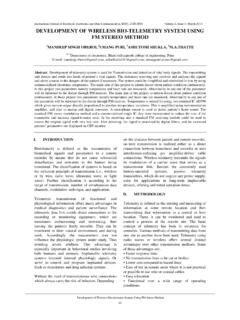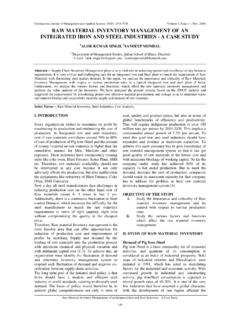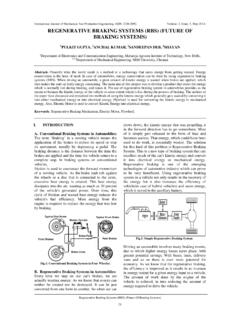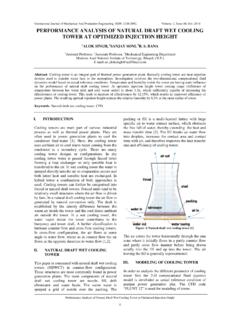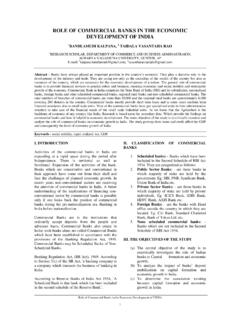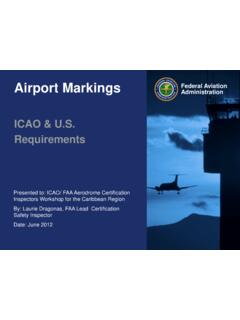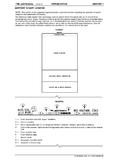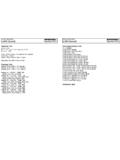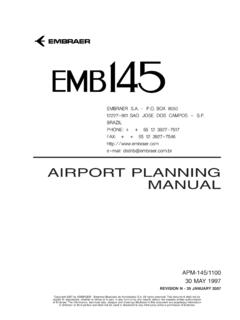Transcription of DESIGN OF AIRPORT RUNWAY BY INTERNATIONAL …
1 INTERNATIONAL Journal of Advances in Science Engineering and Technology, ISSN: 2321-9009 Volume- 2, Issue-3, July-2014 DESIGN Of AIRPORT RUNWAY By INTERNATIONAL Standards 106 DESIGN OF AIRPORT RUNWAY BY INTERNATIONAL STANDARDS 1 KAUSTUBH WAKHALE, 2 SAMEER SURVE, 3 ROHIT SHINDE 1,2,3 Saraswati College of Engineering, Kharghar 410210 Email: Abstract: This paper involves the DESIGN of the INTERNATIONAL RUNWAY for the proposed Navi Mumbai INTERNATIONAL AIRPORT site. The data required for the designing part was taken from the competent authority City Industrial Development Corporation (CIDCO). The RUNWAY has been designed by INTERNATIONAL standards following the DESIGN procedure given by the INTERNATIONAL Civil Aviation Organization (ICAO). Physical characteristics of the RUNWAY and its sections have been studied in depth and designed according to the standards.
2 Images have been provided for better understanding.. The methodology and their references have been specified clearly. Keywords: RUNWAY , ICAO manual Part 1 runways, RUNWAY pavements, Designing of AIRPORT I. INTRODUCTION An AIRPORT is a location where aircraft such as fixed wing aircraft, helicopters, and blimps take off and land. An AIRPORT consists of at least one surface such as a RUNWAY for a plane to take off and land, a helipad, or water for take offs and landing, and often includes buildings such as control towers, hangars and terminal buildings. According to the INTERNATIONAL Civil Aviation Organization (ICAO) a RUNWAY is defined rectangular area on a land aerodrome prepared for the landing and takeoff of aircraft . Runways may be a man-made surface (often asphalt, concrete, or a mixture of both) or a natural surface (grass, dirt, gravel, ice, or salt).
3 The proposed AIRPORT is situated in the geographical centre of Navi Mumbai, at latitude 18 59'40" N and longitude 73 04' 13" E on the National Highway No. 4B near Panvel at a distance of approx. 35 km from the existing Chhatrapati Shivaji INTERNATIONAL AIRPORT (CSIA) in Mumbai. The National Highway 4B provides the main road access to the AIRPORT from the east, whereas the Aamra Marg provides road access to the AIRPORT from the west. The AIRPORT is also accessible from the existing Mankhurd-Belapur-Panvel commuter rail corridor from Khandeshwar Railway Station and from the Targhar Railway Station on the Nerul - Uran Railway line presently under development. The existing AIRPORT at Mumbai, is fast reaching saturation and scope for further enhancement of passenger and cargo handling facilities along with aircraft maintenance and city side facilities appear very much limited.
4 Enhancement of aviation facilities in MMR is critical for maintaining Maharashtra's leadership in attracting Foreign direct Investment and cementing Mumbai's future as an INTERNATIONAL Financial Centre. The air travel demand forecasts for the Mumbai Metropolitan Region reveal that demand will grow from 29 million passengers per annum in the year 2010-11 to 119 million passengers per annum by 2030-31. The Mumbai AIRPORT alone will be unable to handle such an increase in demand. It is therefore imperative to build a second AIRPORT for MMR. II. DESIGN OF THE RUNWAY The DESIGN of the RUNWAY is done in the following order: 1) RUNWAY orientation 2) RUNWAY length calculations 3) RUNWAY pavement 4) RUNWAY marking 5) RUNWAY lightings The designing part is as follows: 1) RUNWAY Orientation: The number and orientation of the runways play an important role in the overall arrangement of various components of an AIRPORT .
5 The number of runways will depend on the volume of air traffic while its orientation will depend on the direction of wind and sometimes on the extend area available for the AIRPORT development. Wind data: The wind data the direction, duration and intensity of the wind were obtained from Indian Metrological Department, Navi Mumbai. Wind Data FIG (1) INTERNATIONAL Journal of Advances in Science Engineering and Technology, ISSN: 2321-9009 Volume- 2, Issue-3, July-2014 DESIGN Of AIRPORT RUNWAY By INTERNATIONAL Standards 107 According to the wind rose diagram FIG (2) the direction of prevailing wind is across WEST-NORTH-WEST direction. For the Orientation of a RUNWAY , WNW direction is very suitable but due to the presence of Matheran hills in SE direction and Belapur residential zone in NW direction. We oriented the RUNWAY in 83 ENE and 263 WSW direction.
6 The cross wind component for the air field is m/s 2) RUNWAY length Calculations: The RUNWAY is designed to carry the takeoff and landing of the largest aircraft in the world A380. The categories of the RUNWAY and their corresponding length and width have defined by INTERNATIONAL CIVIL AVIATION ASSOCIATION (ICAO). A380 falls under the category 4F and the minimum take off run is 2700m and the width of the RUNWAY is 60m. Wind Rose FIG (2) The RUNWAY length is calculated under two constraints: 1. Basic RUNWAY length 2. Actual RUNWAY length 1. Basic RUNWAY length : Basic RUNWAY length is the length calculated under the following assumed conditions, a) AIRPORT altitude is at sea level b) Temperature at the AIRPORT is standard c) No wind is blowing on the RUNWAY d) RUNWAY is levelled in the longitudinal direction e) Aircraft is loaded to its full capacity f) Enroute temperature is standard g) No wind is blowing enroute to the destination Basic RUNWAY length is determined from the take off performance charts and is greater of the either: a) When one of the critical engines fails, the pilot has an option to continue the run or abort the take off after attaining a certain speed called as the decision speed, if he aborts the take off then the take off run and the stop distance should be equal.
7 If both the lengths are equal then the total length is called as the balanced field length . Take off speed (v) = 280km\hr The decision speed is less than or equal to the take off speed Decision speed Take off speed Hence decision speed, Vf = 280km/hr Velocity= (280 1000)/3600 = 78m/s The acceleration is assumed as, a=1m/s Time= v/a= 78/1= 78 s Now, actual velocity is the difference between final velocity and initial velocity. Hence, V = (Vf -Vi)/2 = (78-0)/2 = 39m/s Hence, Total Distance (Take Off Run) = 39 78= 3042 (1) b) When all the engines are operating: 115% Of Take Off run = (115 2700)/ 100 = 3100 (2) Taking maximum value of (1) and (2), Hence, Take Off Run from aircraft s performance = 3100m Now, the landing length requirement Landing Run = 2050 m; Hence safe 2. Actual RUNWAY length : Actual RUNWAY length is the length obtained after applying the corrections of temperature, elevation and slope.
8 The actual RUNWAY length should be adequate to meet the operational requirements of the aircrafts for which the RUNWAY is designed and should not be less than the longest length determined by applying the corrections for local conditions to the operations and performance characteristics of the relevant aircraft. Local conditions that have to be considered are temperature, elevation, slope and humidity and RUNWAY surface characteristics. The length is calculated as follows, a) The basic length selected for the RUNWAY should be increased at the rate of 7% per 300m elevation. RUNWAY elevation at the aerodrome= 3m RUNWAY take off length corrected for elevation = [Take off run .07 ] = [3100 .07 (3/300)] + 3100 = 3102m b) The length of the RUNWAY determined should be further increase at the rate of 1% for every 1 C in the aerodrome reference temperature exceeds over standard atmosphere for the aerodrome.
9 If however, the total correction for elevation and temperature exceeds 35% then the required correction should be obtained by means of specific study. INTERNATIONAL Journal of Advances in Science Engineering and Technology, ISSN: 2321-9009 Volume- 2, Issue-3, July-2014 DESIGN Of AIRPORT RUNWAY By INTERNATIONAL Standards 108 RUNWAY take off length corrected for elevation and temperature = [Take off run (ART Standard Temperature) .01] + Take off run ART= Aerodrome reference temperature = Ta + ((Tm Ta) 3) Where, Tm = the monthly mean of the maximum daily temperature for the hottest month of the year. Ta = the monthly mean of the average daily temperature for the hottest month of the year. Standard temperature is obtained by interpolation from the below given standard temperature table 1: Temperature Data Altitude(m) Temperature( C) 0 500 1000 1500 2000 2500 3000 3500 4000 4500 5000 5500 6000 Table 1 The temperature data was available from the Indian Metrological Department for the period of 1st November 2007 to 31St October 2008 and the month of March was found to be the hottest.
10 Table 2(temp data) Date Temperature Date Temperature Max C Min C Max C Min C 1 March 2008 17 March 2008 2 March 2008 18 March 2008 3 March 2008 19 March 2008 4 March 2008 20 March 2008 5 March 2008 21 March 2008 6 March 2008 22 March 2008 7 March 2008 23 March 2008 8 March 2008 24 March 2008 9 March 2008 25 March 2008 23 10 March 2008 26 March 2008 11 March 2008 27 March 2008 12 March 2008 28 March 2008 34 13 March 2008 29 March 2008 14 March 2008 30 March 2008 36 15 March 2008 31 March 2008 16 March 2008 Table 2 From Table 2, the monthly mean of the average daily temperature for the month of March =Ta = C From Table 2, the monthly mean of the maximum daily temperature for the month of March = Tm = C Therefore, Aerodrome reference temperature = ART = Ta + = C Standard temperature at 3m is found out by interpolation from the Table 1 = C RUNWAY take off length corrected for elevation and temperature = [3102 ( ).]

